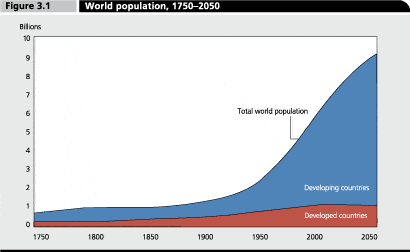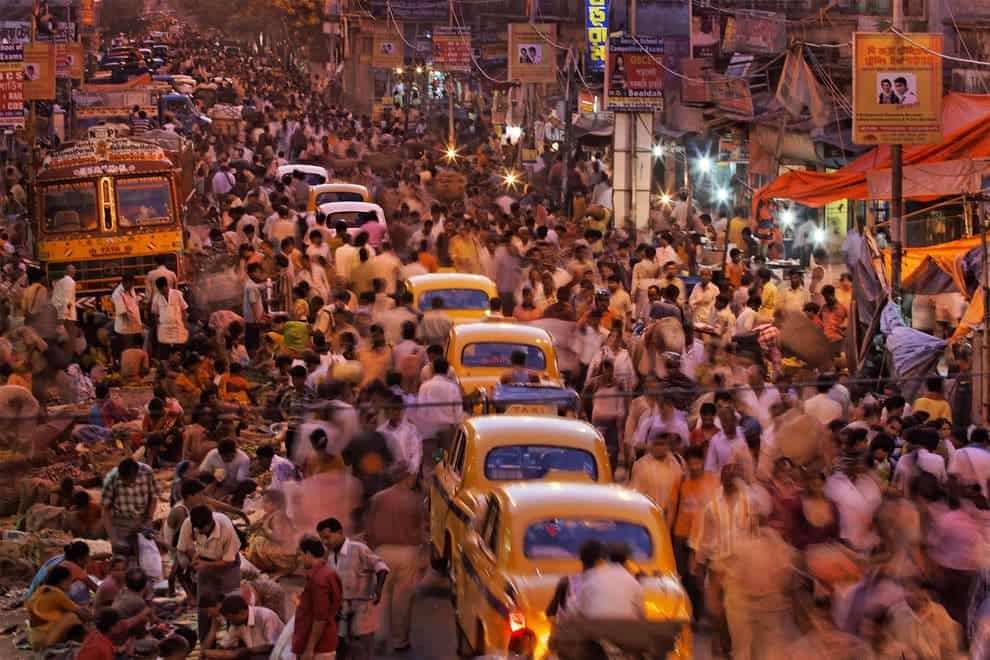Seriously – after making a complex cross-scenario examination, scientists found that given humanity’s current population growth momentum, not even WW3, a global pandemic or stringent fertility restraints will be enough to keep the global population at sustainable levels. In light of these findings, Australian researchers at Univ. of Adelaide’s Environment Institute conclude that lowering our environmental impact through mass scale recycling and shifting to renewable energy in order to control resource usage is the best course of action.

Humans on the rise and there’s no stopping us!
“Global population has risen so fast over the past century that roughly 14% of all the human beings that have ever existed are still alive today. That’s a sobering statistic. This is considered unsustainable for a range of reasons, not least being able to feed everyone as well as the impact on the climate and environment,” said co-author Prof Corey Bradshaw, also from the University of Adelaide.
As I’m typing, there are 7,270,480,091 people alive in the world today and this figure is expected to rise past the 10.4 billion mark by 2100, under current conditions of fertility, mortality and mother’s average age at first childbirth. According to the U.N. Department of Economic and Social Affairs, however, global population growth will stabilize by 2050 – 9.3 billion people are expected to be alive in the world by then, which means only a billion people will be added in 50 years. Population in developed nations will stay about the same at 1.3 billion (fertility in Europe actually sits at 1.5 children per woman, far below the 2.1 ration need to replace the population, but immigration will keep them stocked), but as developing countries in Africa and Asia are expected to experience economic growth, their population is expected to soar from 5.9 billion to 8.2 billion in 2050.

So, how do we feed these many people? The world population doubled from 1960 to 2000, and the pace of food production more than doubled in the same period, but does this mean we can keep up with 10 billion people? Some voices are saying that we are already making enough food to feed 10 billion people and might be able to do so for more. While arable land has remained more or less fixed, food produced per capita has steadily increased. It’s all very relative, anyway, because it involves peeling the question down to “What level or food consumption are we talking about?” and “What level of compromise are we willing to make to the arable soil and food production?”
[RELATED] Humans need an extra planet at current rate of resource depletion, study finds
It’s getting crowded here


These questions are very difficult to answer, partly because it’s not only about food anymore – people need access to energy, water, education etc. These all take their strains on nature and the planet and are expected to grow, not only because of an increasing population, but also due to an enhanced standard of living. The average person living in 2100 will be far more wealthy than the average person living today, but of course that doesn’t mean they will live a better life – it’s an important distinction. They might not live a better life because even though they’re wealthier, if this wealth is accumulated under present conditions, then they most likely live in a world that’s been transformed by climate change, arguably for the worse.
According to a recently released UN report, here are some key assumptions regarding the world of 2100, with double the population of today, and what might happen in between:
- the growing populace could have wide-ranging impacts on the environment, economy, and health, including maternal and child mortality and lagging government investments in health, education, and infrastructure.
- of the 7.3 billion currently living in the world, one billion use most of the resources. This tells us that the number of people in the world isn’t that important – it’s the way these people use resources that bears the most consequences. Take, for instance, China. The country’s population will reach its peak by 2030 and then steadily fall, mirroring the trendline seen today in developed countries like the US. At the same time, China and countries like it, will experience a massive increase in the quality of life, ie: they will want more consumer electronics and, maybe most importantly, more meat. Consider that by 2022, half of the world’s feed crops will be eaten by, wait for it, Chinese pigs. So, what the UN and world governments need to work on together is to find a solution to this problem (i.e. less meat, more renewable energy sources etc).
- More than half of the global population growth is expected to happen in Africa, with numbers expecting to reach 1.3 billion by 2050. Countries like the Democratic Republic of Congo, Niger, Somalia, Uganda, and others will see five-fold increase by 2100.
- Asia is expected to contribute with one extra billion people by 2100. While China has the largest population today, India will surpass it in just seven years.
- On the other hand, some developed regions could see the population decreasing by as much as 15%. To maintain a current population, scientists estimate each mother needs to birth 2.1 babies (one for each parent), but the birth rate in Europe right now is only 1.6 children per woman. Of course, immigrants from crowding regions will makeup.
- Wilmoth suggests lowering fertility rates by massive deployment of contraceptives as a way to curb population growth in key areas where there’s a risk of overcrowding. “People will find a way to find birth control, one way or another,” he said. “They are often dangerous and not as effective compared to if they have modern services provided to him.”
- The world’s population is rising faster than doctors can keep up. World Health Organization determined that for every 1,000 people on the planet, there is a need for 2.3 doctors, nurses, and midwives. According to this ratio, for the 9.7 billion people expected to live on the planet in 2050, more than 22 million healthcare workers will be needed to care for them. At the same time, WHO estimates a global healthcare worker shortage of 12.9 million people by 2035.
- By 2020, a new demographic milestone will be reached: The number of elderly will exceed the number of infants.
- People over the age of 65 will increase to 1.5 billion, mostly in developed countries. That means 16 percent of the world’s population will be elderly. This implies a shift of the main global health risks from infectious to chronic diseases like heart disease, cancer, and diabetes. Efforts will be required to help the elderly live better and healthy, not just longer. If people who are 65 in 2100 can feel as healthy as an average 55 year old today, then there might be reason to believe these people can work for 10 more years and thus lessen the strain on social care and society as a whole.

PHOTOGRAPH BY RANDY OLSON, NATIONAL GEOGRAPHIC CREATIVE
Some would say that the world will never reach 10 billion people, however. Wars, plagues and a world government may prevent this from happening. That may be true, but according to the National Academy of Sciences, even if all these scenarios would occur at the same time, given our current momentum, the world’s population would still hang at an unsustainable level. For instance, the second world war claimed between 50 million and 85 million military and civilian lives – it was the most lethal conflict, by absolute numbers, in human history. World war one claimed some 37 million lives. Using a computer model based on demographic data from the World Health Organisation and the US Census Bureau, the researchers found that an eventual World War III would be only slightly curve population.
[INTERESTING] How much does the world’s population weigh?
“We were surprised that a five-year WW3 scenario, mimicking the same proportion of people killed in the first and second world wars combined, barely registered a blip on the human population trajectory this century,” said Prof Barry Brook, who co-led the study at the University of Adelaide, in Australia.
Climate change, war, reduced mortality and fertility, and increased maternal age altered this prediction only slightly. A devastating global pandemic that killed 2 billion people was only projected to reduce population size to 8.4 billion, while 6 billion deaths brought it down to 5.1 billion. There’s nothing that seems to stop humans from growing and growing.
He added: “We examined various scenarios for global human population change to the year 2100 by adjusting fertility and mortality rates to determine the plausible range of population sizes at the end of this century. Even a worldwide one-child policy like China’s, implemented over the coming century, or catastrophic mortality events like global conflict or a disease pandemic, would still likely result in 5-10 billion people by 2100.”
Reducing global impact, not population, is the key
Of course, fertility efforts through better family planning by the world’s governments part have an important role to play – this will lead to hundreds of millions fewer people to feed by mid-century. But this isn’t a solution – it’s just a side of it; a demographic ‘quick fix’. What the Australian researchers argue is that in light of these nine scenarios they analyzed, ranging from ‘business as usual’ to to highly unlikely broad-scale catastrophes resulting in billions of deaths, the only viable solution is to reduce humanity’s impact on the environment. This means less resources used per capita and increasing our renewable energy share.
“It will take centuries, and the long-term target remains unclear,” said the report published in PNAS. “However, some reduction could be achieved by mid-century and lead to hundreds of millions fewer people to feed. More immediate results for sustainability would emerge from policies and technologies that reverse rising consumption of natural resources.”


